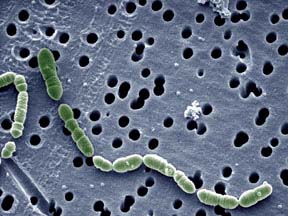Genus/species: Oenococcus oeni (Leuconostoc oenos)
Gram Stain: Gram positive
Cell Morphology:
ellipsoidal to spherical cocci, often in pairs or chains
Cell Image:

Colony Morphology:
Colonies develop after a few days. They are typically less than 1mm in diameter, smooth, round and greyish white. Colony growth is optimal at 20 to 30ºC on a sugar and protein rich medium that contains tomato juice substrate or grape juice.
Liquid Growth:
dispersed
Physiological Traits:
O. oeni ferments sugars using both the hexose-monophosphate and phosphoketolase pathways using the enzymes Glucose-6-phosphate and xylulose-5-phosphoketolase to from D(-)-lactic acid, CO2 and ethanol in equal amounts when metabolising D-glucose. O.oeni can convert pentose phosphate to acetic acid in an oxygen dependant reaction which requires NADP. It cannot metabolize polysaccharides and alcohols.
O.oeni can decarboxylate L-malate to L(+)-lactate, but cannot use it as a sole source of carbon. It requires the amino acids Glutamic acid, valine, guanine, adenine, xanthine, uracil, riboflavin, folic acid, nicotinic acid, thiamine, biotine and pantothenic acid. There is some variation of amino acid requirement between strains.
Ecological Traits:
Found in musts and wines and fruit mashes
Distinguishing Features:
Heterofermentative, growth in acid media below pH 3.0, ethanol tolerant at 10%, requirement for tomato juice growth factor, lack NAD-dependent glucose-6-phosphate dehydrogenase, only produce D-lactic acid. They can be separated from Leuconostoc species baceause they use saccharose, lactose and maltose as a substrate.
Role in wine:
Part of the normal grape and fermentation flora in wine. Desired for malolactic fermentation at low pH.
Sensitivities:
- SO2: Yes
- Sorbate:
- DMDC:
- pH:
- Acids: No
- Ethanol: No
- Anaerobiosis:
- Heat : high temp
References:
Boulton, R.B., Singleton, V.L., Bisson, L.F., Kunkee, R.E. Principles and Practices in Winemaking. Springer Science. 1999.
Dicks, L. M., F. Dellaglio, and M. D. Collins. 1995. Proposal to reclassify Leuconostoc oenos as Oenococcus oeni [corrig.] gen. nov., comb. nov. International Journal of Systematic Bacteriology 45:395-7.
Dicks, L.M., Endo, A. Taxonomic Status of Lactic Acis Bacteris in Wine and Key Characteristics to Differentiate Species. Depatment of Microbiology, Stellenbosch University, 2009.
Sarah Harper. 2010 UC Davis VEN128 Wine MicrobiologySubmittal
